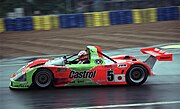
Mazda Motor Corporation, also known as simply Mazda, is a Japanese multinational automotive manufacturer headquartered in Fuchū, Hiroshima, Japan. The company was founded on January 30, 1920, as Toyo Cork Kogyo Co., Ltd., a cork-making factory, by Jujiro Matsuda. The company acquired Abemaki Tree Cork Company. It changed its name to Toyo Kogyo Co., Ltd. in 1927 and started producing vehicles in 1931. The name Mazda was derived from Ahura Mazda, the god of harmony, intelligence and wisdom in Zoroastrianism, as well as from the surname of the founder. Mazda is one of the largest automakers in Japan and the world. In 2015, it produced 1.5 million vehicles for global sales, of which nearly one million were made in Japan and the rest in various other countries. It ranked as the 15th-largest automaker by production volume globally in 2015. Mazda is known for its innovative technologies, such as the Wankel engine, the SkyActiv platform, and the Kodo Design language. It also has a long history of motorsport involvement, winning the 24 Hours of Le Mans in 1991 with the rotary-powered Mazda 787B. Mazda has several alliances and partnerships with other automakers, such as Toyota, Nissan, Isuzu, Suzuki and Ford.

The Wankel engine is a type of internal combustion engine using an eccentric rotary design to convert pressure into rotating motion. The concept was proven by German engineer Felix Wankel, followed by a commercially feasible engine designed by German engineer Hanns-Dieter Paschke. The Wankel engine's rotor, which creates the turning motion, is similar in shape to a Reuleaux triangle, with the sides having less curvature. The rotor spins inside a figure-eight-like epitrochoidal housing around a fixed-toothed gearing. The midpoint of the rotor moves in a circle around the output shaft, rotating the shaft via a cam.

The Mazda RX-7 is a front-engine, rear-wheel-drive, rotary engine-powered sports car that was manufactured and marketed by Mazda from 1978 until 2002 across three generations, all of which made use of a compact, lightweight Wankel rotary engine.
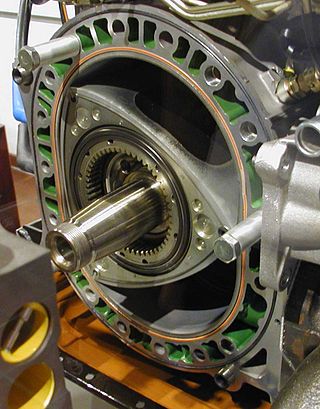
The Mazda Wankel engines are a family of Wankel rotary combustion car engines produced by Mazda.

The Mazda 787 and its derivative 787B are Group C sports prototype racing cars that were developed by Japanese automobile manufacturer Mazda for use in the World Sportscar Championship, All Japan Sports Prototype Championship, and the 24 Hours of Le Mans from 1990 to 1991. Designed to combine a mixture of the Fédération Internationale du Sport Automobile (FISA) Group C regulations with the International Motor Sports Association (IMSA) GTP regulations, the 787s were the last Wankel rotary-powered racing cars to compete in the World and Japanese championships, using Mazda's R26B engine.
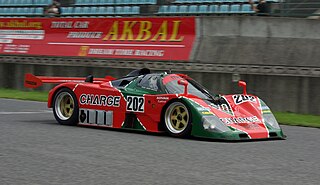
The Mazda 767/767B are prototype racing cars that were built by Mazdaspeed for the 24 Hours of Le Mans running under the IMSA-spec GTP class. The 767 replaced the 757 in 1988, upgrading to a newer and larger 4-rotor 13J Wankel engine which produced nearly 600 hp (450 kW).
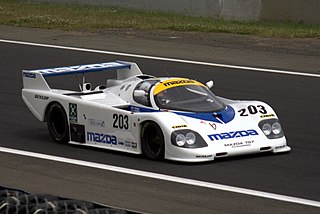
The Mazda 757 is a prototype racing car built by Mazdaspeed for the 24 Hours of Le Mans running under the IMSA-spec GTP class. It replaced the previous lineage of Group C2 class cars which ended with the 737C and was the first chassis built entirely by Mazdaspeed and designed by Nigel Stroud. The 747 designation was skipped to avoid confusion with the second generation Mazda RX-7, which was developed under the codename P747. The 757 used a new 3-rotor 13G Wankel engine.

The Mazda 737C is a prototype racing car that was built for Mazdaspeed for the 24 Hours of Le Mans under the Group C2 formula. It was the final evolution of the initial Mooncraft built design dating back to the 717C. It again used a 2-rotor 13B Wankel engine.

The 1996 24 Hours of Le Mans was the 64th Grand Prix of Endurance, and took place on 15 and 16 June 1996. It was won by a Tom Walkinshaw-Porsche prototype run by Joest Racing with drivers Davy Jones, Manuel Reuter and Le Mans rookie Alexander Wurz completing 354 laps. While not being the fastest car on track, it hit the front in the first hour and aside from several pit-stop overlaps, was never headed as other teams hit mechanical troubles during the race. This was Reuter's second Le Mans victory, and the first for Jones and Wurz, who, at 22 years old, became the youngest ever Le Mans overall winner.

The 1995 24 Hours of Le Mans was the 63rd Grand Prix of Endurance, and took place on 17 and 18 June 1995 in one of the wettest races in the event's history with about 17 hours of steady rain. The race was won by the #59 McLaren F1 GTR driven by JJ Lehto, Yannick Dalmas and Masanori Sekiya entered in the GT1 category. This was the first Le Mans win for a driver from Finland and for a driver from Japan. It was also McLaren's first win, at its first attempt - Ferrari had accomplished the same feat with its two cars in 1949, but other manufacturers like Jaguar, Porsche, Ford or Audi achieved their first Le Mans win only after 2, 3 or more attempts. As well as its outright win, the strength of the F1 GTR in the race was underlined by it ultimately filling four of the first five places.

The Mazda MXR-01 is a Group C sports prototype that was used by Mazda's factory team Mazdaspeed in the 1992 World Sportscar Championship season. It would be the final Mazda entry in sports car racing since the inception of its Le Mans project in 1983. It was based on the Jaguar XJR-14.

IMSA GT was a sports car racing series organized by International Motor Sports Association. Races took place primarily in the United States and occasionally in Canada.

The Mazda Furai was a concept car revealed on 27 December 2007 and designed by Swift Engineering and manufactured by Mazda. A teaser image of the vehicle was released on 11 December 2007. The Furai officially debuted at the 2008 North American International Auto Show in Detroit.
James Downing is an American former professional race car driver, he is a five-time IMSA Championship winner, owner/driver of Downing/Atlanta Racing, and was principal in the development of the HANS device.
Leigh Miller Racing was a team in the Indy Racing League and the IMSA GT Championship created by sportscar driver Leigh Miller in 1994. After competing at the IMSA Supercar Championship in 1993, Miller stepped up to IMSA GT, first with a Porsche 968 and a Porsche 944 Turbo for the GTU, before acquiring two Mazda-developed Kudzu prototypes for the WSC class and setting up his own team.
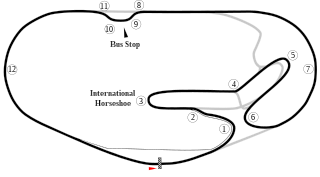
The 1993 Rolex 24 at Daytona was a 24-hour endurance sports car race held on January 30–31, 1993 at the Daytona International Speedway road course. The race served as the opening round of the 1993 IMSA GT Championship.
The Argo JM16 is an IMSA GTP Lights sports prototype race car, designed, developed and built by Argo Racing Cars, in 1984. It competed in the IMSA GT Championship sports car racing series between 1984 and 1993. It, unfortunately, did not win any races, however, it did achieve 11 class victories, and one 3rd-place podium finish. It was powered by three different naturally aspirated engines; a Ford-Cosworth DFV Formula One engine, a Buick V6, and a Mazda 13B Wankel 2-rotor engine.
The Kudzu DG-1 is an IMSA GTP Lights sports prototype race car, designed, developed and built by American racing driver Jim Downing; making its debut in 1989. It competed in the IMSA GT Championship between 1989 and 1993. It was powered by either a Mazda 13B Wankel rotary engine, or a Buick V6 engine. Its best result was a 5th-place finish, and it achieved 4 class wins.
The Kudzu DG-2 is an IMSA GTP Lights sports prototype race car, designed, developed and built by American racing driver Jim Downing, to compete in sports car racing, between 1992 and 1999. It debuted at the 1992 12 Hours of Sebring. Its best result was a third-place race finish, and it achieved ten class wins. It was powered by a naturally-aspirated 3.4 L (210 cu in) Buick V6 engine. Only 3 models were manufactured and produced.
The Alba AR3, and its derivative, the Alba AR3-001, were a series of ground effect IMSA GTP/Group C junior (C2) sports prototype race car, designed, developed and built by Italian manufacturer and constructor, Alba Engineering in 1984, and used in sports car racing until 1988. Its best result was two 4th-place finishes; first at Lime Rock in 1984, being driven by Gianpiero Moretti, and the second at Kyalami in 1987, being driven by Maurizio Gellini and Ranieri Randaccio. It was powered by a number of different engines, including a naturally-aspirated 4.5 L (270 cu in) Buick V6 engine, a turbocharged 4.0 L (240 cu in) Buick Indy V6 engine, a 1.3 L (79 cu in) Mazda 13B 2-rotor wankel rotary engine, a naturally-aspirated 3.0 L (180 cu in) Ford-Cosworth DFV Formula One engine, and a derived 3.3 L (200 cu in) Ford-Cosworth DFL.

